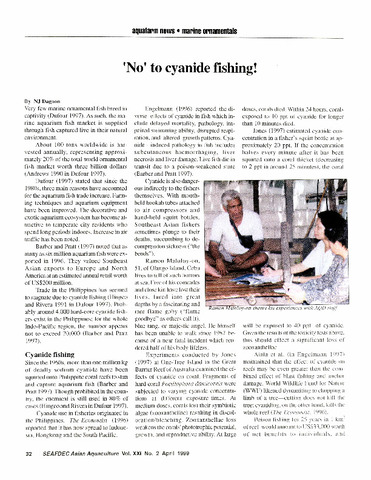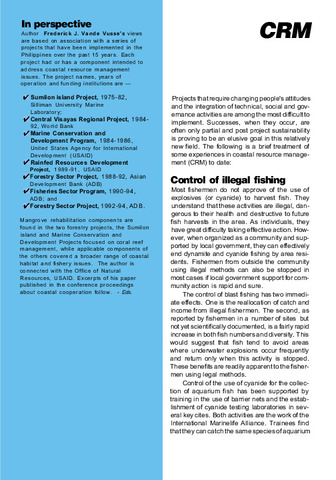| dc.contributor.author | Pakingking, Rolando V., Jr. | |
| dc.contributor.author | Mori, Koh-Ichiro | |
| dc.contributor.author | Bautista, Norwell Brian | |
| dc.contributor.author | de Jesus-Ayson, Evelyn Grace | |
| dc.contributor.author | Reyes, Ofelia | |
| dc.date.accessioned | 2014-06-23T02:31:25Z | |
| dc.date.available | 2014-06-23T02:31:25Z | |
| dc.date.issued | 2011 | |
| dc.identifier.citation | Pakingking Jr., R., Mori, K.-I., Bautista, N. B., de Jesus-Ayson, E. G., & Reyes, O. (2011). Susceptibility of hatchery-reared snubnose pompano Trachinotus blochii to natural betanodavirus infection and their immune responses to the inactivated causative virus. Aquaculture, 311(1-4), 80–86. | en |
| dc.identifier.issn | 0044-8486 | |
| dc.identifier.uri | http://hdl.handle.net/10862/2116 | |
| dc.description.abstract | Mass mortality of snubnose pompano Trachinotus blochii fry exhibiting dark coloration, anorexia, and abnormal swimming behavior was recently documented at the hatchery of the Aquaculture Department of the Southeast Asian Fisheries Development Center, Philippines. Samples of brain tissues were collected from affected fish and processed for RT-PCR amplification and virus isolation in cell culture. Infected E-11 cells exhibited cytopathic effect characteristic of betanodavirus. Histopathology of moribund fish showed pronounced vacuolations in the brain, spinal cord, and retina. An RT-PCR product of approximately 430 bp was amplified from the culture supernatant of betanodavirus-infected E-11 cells and sequenced. Sequencing of the T4 region of the coat protein gene (RNA 2) revealed clustering of the isolated virus within the red-spotted grouper nervous necrosis virus type. The pathogenicity of the isolated betanodavirus in healthy pompano juveniles and fry was determined via intramuscular injection and immersion challenges, respectively. Higher mortality rates were obtained in challenged fish compared with the controls. An inactivated vaccine was subsequently prepared by treating the clarified betanodavirus with formalin. Pompano juveniles intraperitoneally injected with the inactivated vaccine exhibited neutralizing antibodies from days 15 (mean titer 1:240) to 125 (1:560) with the highest titer noted at day 64 (1:2240) post-vaccination. Additionally, pompano fry bath-vaccinated and consequently bath-challenged with betanodavirus at day 35 post-vaccination showed higher survival rate compared with the control, indicating the potential of the inactivated betanodavirus vaccine against VNN in pompano fry and juveniles. | en |
| dc.description.sponsorship | This study was funded by SEAFDEC/AQD (study code: 5203-T-RD FH0507) and the Government of Japan Trust Fund through the Regional Fish Disease Project (study code: 8001-T-FD-FH0507). We would like to thank Dr. Takuma Sugaya of Fisheries Research Agency, Oita, Japan, for the invaluable help on sequencing and phylogenetic analysis and Dr. Felix Ayson for the critical review of the manuscript. | en |
| dc.language.iso | en | en |
| dc.publisher | Elsevier | en |
| dc.subject | Trachinotus blochii | en |
| dc.subject | Philippines | en |
| dc.subject | pompanos | en |
| dc.subject | Viral nervous necrosis | en |
| dc.subject | VNN | en |
| dc.title | Susceptibility of hatchery-reared snubnose pompano Trachinotus blochii to natural betanodavirus infection and their immune responses to the inactivated causative virus | en |
| dc.type | Article | en |
| dc.citation.volume | 311 | |
| dc.citation.issue | 1-4 | |
| dc.citation.spage | 80 | |
| dc.citation.epage | 86 | |
| dc.citation.journalTitle | Aquaculture | en |
| dc.subject.asfa | brain | en |
| dc.subject.asfa | disease control | en |
| dc.subject.asfa | fish culture | en |
| dc.subject.asfa | fish kill | en |
| dc.subject.asfa | marine fish | en |
| dc.subject.asfa | marine fisheries | en |
| dc.subject.asfa | mortality causes | en |
| dc.subject.asfa | polymerase chain reaction | en |
| dc.subject.asfa | vaccines | en |
| dc.subject.asfa | immunity | en |
| dc.subject.asfa | vaccination | en |
| dc.identifier.doi | 10.1016/j.aquaculture.2010.11.035 | |
| local.subject | Betanodavirus | en |



